The Odyssey spacecraft arrived at Mars on Oct. 30, 2001, after an interplanetary journey lasting 200 days, firing its main engine in order to be captured into orbit around the red planet. We already knew quite a bit about this nearby planet, from previous orbiting space probes and landing craft. Beginning with the first Soviet attempts in 1960, around 30 missions had visited the planet by 2001, although only 10 or so had done so without problems. Since the time of writing this, many more spectacular missions have sent back some amazing pictures. Visit NASA here for more up-to-date information.
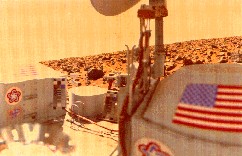 Mars' atmosphere is thin, cold, dry, and nearly all carbon dioxide. Strong winds blow at speeds exceeding 100 miles per hour, causing large dust storms, which erode the surface. These winds are caused by slightly warmer temperatures on Mars as it gets nearer the sun in its orbit; Mars' orbit is much more eccentric than earth's. Mars' atmosphere is thin, cold, dry, and nearly all carbon dioxide. Strong winds blow at speeds exceeding 100 miles per hour, causing large dust storms, which erode the surface. These winds are caused by slightly warmer temperatures on Mars as it gets nearer the sun in its orbit; Mars' orbit is much more eccentric than earth's.
The huge dust storms combine with carbon dioxide ice in the atmosphere, creating a haze in the air, and causing the sky to appear yellow, as shown in the Viking Lander photograph at the right. See a 3D panorama of Mars. (red/green glasses needed)
Earth's blue sky is caused by the scattering of light in the atmosphere by objects which are small in comparison to the light's wavelength. Visible light from the sun contains a mixture of colours, each corresponding to a different wavelength. Sunlight streaming into the Earth's atmosphere from one direction is scattered in all directions, as it encounters air molecules. Shorter wavelengths of light (the blue end of the spectrum) are scattered more than longer wavelengths (the red end of the spectrum). An observer perceives blue light coming in from all directions, so the sky appears blue. If there were no atmosphere, the sky would appear black, like the sky seen in Apollo pictures from the moon.
On Mars, some of the dust particles in the air contain magnetite (a black, opaque mineral) which absorbs sunlight more effectively at blue wavelengths than at red wavelengths. In addition, larger dust particles both reflect and absorb sunlight. These factors result in Mars' yellowish sky color.
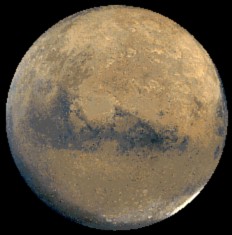 Mars' rotational axis is tilted at an angle of 25°, much like Earths (at 23°) This causes Mars to experience 'seasons', as one hemisphere or the other is tilted towards the sun during Mars' orbit. Temperature changes cause large winds, hazier sky, and many cirrus-like clouds of carbon dioxide. (There are no water clouds in the Martian sky; because of the temperature and pressure, water turns from solid to gas.) Mars' rotational axis is tilted at an angle of 25°, much like Earths (at 23°) This causes Mars to experience 'seasons', as one hemisphere or the other is tilted towards the sun during Mars' orbit. Temperature changes cause large winds, hazier sky, and many cirrus-like clouds of carbon dioxide. (There are no water clouds in the Martian sky; because of the temperature and pressure, water turns from solid to gas.)
The Martian atmosphere 3.8 billion years ago was thicker, warmer, wetter and more able to support life. Over the following billions of years, most of it has escaped into space. Today, very little water vapour can be found in the Martian atmosphere. If all the water in the Martian atmosphere were to turn to rain it would make a puddle less than a hundredth of a centimeter deep. The source of this small amount of atmospheric water vapour are the polar caps, from which tiny quantities of water vapour sublime during spring and summer.
In addition, there is about 10 times this amount of water in the top few centimeters of the Martian soil.
The pattern of crater erosion on the surface of Mars indicates a surface drainage flow of some kind. This tells us that the atmosphere must have been significantly warmer at some point in the past, warm enough to allow substances, at least temporarily, to assume liquid form. Scientists speculate that CO2 was released in sufficiently high amounts by volcanoes to create a greenhouse effect and warm the planet, allowing liquid water to flow temporarily and erode the surface. It is this supposed existence of ancient liquid water which allows for the possibility of life (at some time in the past) on Mars. Perhaps pockets of life remain, clustered around small sources of water, under the soil.
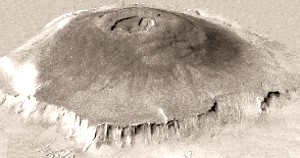 Volcanoes Volcanoes
There are many inactive volcanoes on Mars. The largest shield volcanoes are basaltic, like volcanoes in Hawaii and Iceland. Olympus Mons is one such volcano, and is the largest mountain feature known anywhere in the solar system; it is so large, it would cover the state of Arizona.
|
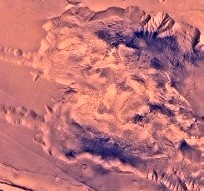 Canyons Canyons
The surface of Mars also includes many of the largest canyons in the solar system. Valles Marineris is the largest of them all. This huge canyon system is 5,000 km long, up to 240 km wide, and 6.5 km deep. If this canyon were located in the United States, it would stretch all the way from California to Virginia.
The picture at the left shows west Candor Chasma, one of the connected valleys of Valles Marineris. This section is about 150 km wide. The light-coloured rubble-filled areas may be deposits resulting from the collapse of the walls of the canyon due to the melting of ice at some point in the past.
Moons
Mars has two small, irregularly shaped moons, called Phobos and Deimos. Much of what we know about them comes from the Mariner, Viking and (Soviet) Phobos missions. In 1977, Viking Orbiter 1 did a flyby of Phobos, the larger, inner Martian moon, coming within 90 km of the surface. At about the same time, Viking Orbiter 2 flew by Deimos, the smaller moon, at a distance of only 22 km. Pictures revealed details as small as several metres.
|
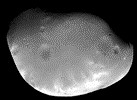
Deimos
|
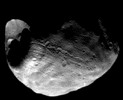
Phobos
|
The Soviet Phobos missions were probes intended to land on Phobos. While these missions took many photographs of Phobos, both probes were unsuccessful at landing on the surface.
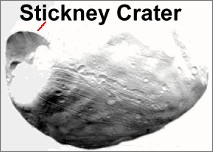 One of the most unusual features of Phobos, aside from its irregular shape, is the huge crater, named Stickney Crater, on one end. Phobos itself is only 28 km long and 20 km wide, so the moon must have been nearly shattered completely by the force of the impact that caused this crater. Surface fractures are evident in the photo (right) of Phobos' surface; these grooves are about 700 metres wide and 90 metres deep near the edge of the crater. One of the most unusual features of Phobos, aside from its irregular shape, is the huge crater, named Stickney Crater, on one end. Phobos itself is only 28 km long and 20 km wide, so the moon must have been nearly shattered completely by the force of the impact that caused this crater. Surface fractures are evident in the photo (right) of Phobos' surface; these grooves are about 700 metres wide and 90 metres deep near the edge of the crater.
|
Both moons are very similar in composition, size, and shape, to asteroids; it is possible that they were in fact originally asteroids, captured by the gravity of Mars, ... although one or the other may have also formed by material accreting during the formation of Mars itself. No definitive answer to how the moons were formed is accepted by all scientists, as of this writing.
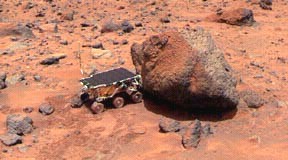 Previous NASA missions to Mars have revealed much about the surface of the planet. A Mars Rover released on the surface was controlled from Earth, and before contact was lost, returned some spectacular pictures of the rock-strewn landscape.
Previous NASA missions to Mars have revealed much about the surface of the planet. A Mars Rover released on the surface was controlled from Earth, and before contact was lost, returned some spectacular pictures of the rock-strewn landscape.
Mars' reddish colour is the result of iron oxide (rust) in the soil, and the surface is eroded in many places by dust storm activity. So far, no evidence of living material or water has been found, although the exploration to this point has been extremely limited.
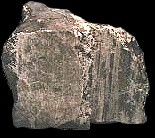 Indirect evidence of life on Mars was recently released when researchers found magnetic material in several 3 to 4.5 billion year old Martian meteorites, that could only have been produced by bacteria. The meteorites, found on Earth, made their way here after being blown from the surface of Mars by huge crater-forming impacts of large objects. Both meteorites show evidence of microfossils and other remnants of early life. Clusters of very small spheres found in the meteorites are very similar to those seen in bacteria-containing samples from deep beneath the Earth's surface. They are embedded in clays that are clearly of Martian origin, suggesting that they too were formed on Mars.
Indirect evidence of life on Mars was recently released when researchers found magnetic material in several 3 to 4.5 billion year old Martian meteorites, that could only have been produced by bacteria. The meteorites, found on Earth, made their way here after being blown from the surface of Mars by huge crater-forming impacts of large objects. Both meteorites show evidence of microfossils and other remnants of early life. Clusters of very small spheres found in the meteorites are very similar to those seen in bacteria-containing samples from deep beneath the Earth's surface. They are embedded in clays that are clearly of Martian origin, suggesting that they too were formed on Mars.
Further evidence from the meteorites includes magnetite crystals identical to those produced and used by aqueous bacteria on Earth. Additional studies showed that a substantial portion of the hydrocarbons found in the meteorites were in them when they left Mars, and are not the result of terrestrial contamination. There is also evidence that most of the carbonates in the meteorites were formed when Mars was warmer and wetter - an environment much more favourable to life than the current surface of Mars.
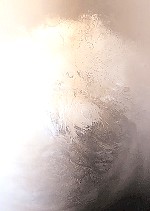 Odyssey won't be alone at Mars. The Mars Global Surveyor spacecraft has been in orbit around Mars for about four years. The photo at the right is a view of the Martian south polar region, taken in September 2001. Odyssey won't be alone at Mars. The Mars Global Surveyor spacecraft has been in orbit around Mars for about four years. The photo at the right is a view of the Martian south polar region, taken in September 2001.
The bright area at the center is the permanent south polar cap, the part that will remain through the summer. The bright areas surrounding the center are the seasonal frost cap that is deposited during winter in the southern hemisphere. The hazy zone that covers most of the left side of the image is afternoon clouds and fog.
The polar frosts contain both water and carbon dioxide ices. Clouds of condensing water ice crystals are common.
To get an idea of the surface area covered by this photo, the permanent cap at the center of the image is about 420 km (260 mi) across. Sunlight illuminates the scene from the upper left
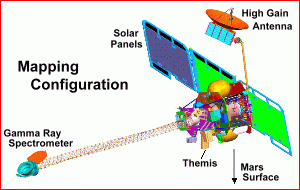 Now that the Odyssey and other spacecraft have reached Mars, we should soon be learning a lot more about this planet. The probe is very sophisticated, and includes an instrument package called Themis. When Odyssey is in its mapping configuration, with the solar panels fully extended, it will be able to take detailed photographs of the surface, using visible light as well as other wavelengths. Now that the Odyssey and other spacecraft have reached Mars, we should soon be learning a lot more about this planet. The probe is very sophisticated, and includes an instrument package called Themis. When Odyssey is in its mapping configuration, with the solar panels fully extended, it will be able to take detailed photographs of the surface, using visible light as well as other wavelengths.
After entering orbit, the craft will use aerobraking (friction with the upper layers of Mars' atmosphere) to eventually end up in a circular 2-hour orbit, only 400 kilometres above the planet's surface. Odyssey's instruments and cameras will explore the climate and geology of Mars, including a search for water and evidence of life-sustaining environments.
Two rovers have also recently arrived on the surface of Mars. Have a look at a large spectacular panoramic view of the surface of Mars taken by the rover Spirit. This large image may take a minute or two to load.
Below is a panoramic image of the Martian sunset also taken by Spirit, in 2005. Twilight on Mars lasts for about 2 hours; the long duration is caused by sunlight scattered around to the night side of the planet by high altitude dust. Similar long twilights sometimes occur on Earth when tiny dust particles are erupted from powerful volcanoes.
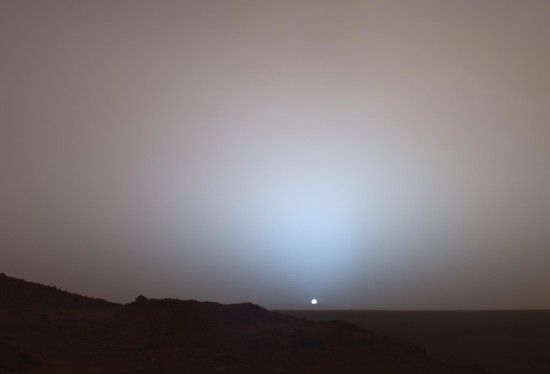
Have a look at more recent Mars photographs
Some of the information and photographs on this page relating to the Mars Odyssey mission were obtained from NASA's own excellent site The Odyssey Mission. Visit this site for more detailed information about the mission, and up-to-date results.
Here is a useful table of facts about Mars, which may be printed.
|